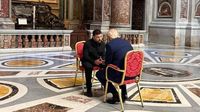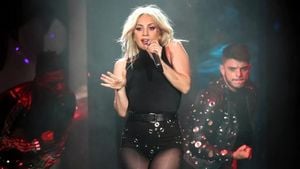The funerals of Pope Francis brought world leaders together in Rome on April 26, 2025, creating a unique backdrop for significant diplomatic discussions. Among the attendees were former U.S. President Donald Trump and Ukrainian President Volodymyr Zelensky, who met in St. Peter's Basilica, marking a pivotal moment in international relations.
Trump and Zelensky's meeting, which lasted about 15 minutes, has been hailed as a legacy of Pope Francis's efforts for peace. The White House described the encounter as "very productive," while Zelensky referred to it as potentially historic, emphasizing its symbolic value. He noted, "This meeting has the potential to become historic if we achieve joint results." This diplomatic engagement came at a time when discussions surrounding a ceasefire in Ukraine were intensifying, with Trump suggesting a ceasefire could begin as soon as May 1, 2025.
During their conversation, Zelensky presented a counterproposal to Washington's peace plan, which Ukraine deemed too favorable to Moscow. The Ukrainian stance includes requests not to limit the size of its army and to deploy a European security contingent backed by the U.S. on Ukrainian territory. Zelensky acknowledged that NATO membership is not currently a priority, stating that pragmatism is essential in the current phase of negotiations.
While the meeting between Trump and Zelensky was a highlight, it was not the only significant interaction that day. The two leaders were joined by French President Emmanuel Macron and British Prime Minister Keir Starmer in St. Peter's Basilica, further showcasing the day's diplomatic significance. Additionally, Italian Prime Minister Giorgia Meloni hosted Zelensky at Palazzo Chigi for discussions, and she also shared a meal with Argentine President Javier Milei.
Meloni remarked on the importance of the Trump-Zelensky meeting, stating, "Seeing Donald Trump and Volodymyr Zelensky discussing peace at the funeral of the 'Pope of Peace' carries enormous significance." This sentiment was echoed by Macron and Meloni, who emphasized that Zelensky agrees on the goal of achieving an unconditional ceasefire.
However, not everyone is optimistic about the outcomes of such high-profile meetings. German President Frank-Walter Steinmeier cautioned against placing too much hope in what he termed "funeral diplomacy." He stated, "We shouldn’t expect significant foreign policy to be conducted on the sidelines of these commemorative ceremonies." This highlights the skepticism surrounding the effectiveness of diplomatic discussions held in such contexts.
On the ceremonial side, Trump's choice of attire—a relatively light blue suit—stood out among the predominantly black suits worn by other dignitaries. While his spokesperson, Karoline Leavitt, affirmed that Trump looked great, fashion editor Vanessa Friedman noted that for someone like Trump, who is acutely aware of the power of appearance, the choice likely wasn't accidental. Trump had previously worn black at the funeral of former President Jimmy Carter, suggesting that his outfit choice was a deliberate statement.
Trump's prominent position in the front row at the funeral was also a topic of discussion. According to Vatican protocol, seating is assigned alphabetically by country, with the official language of diplomacy being French. This means that "United States of America" translates to "États-Unis d'Amérique," placing Trump ahead of many other leaders. Security considerations also played a role in his seating arrangement, allowing him to exit quickly after the ceremony.
In contrast to Trump's visibility, President Joe Biden faced challenges in attending the funeral. He arrived late due to complications boarding the plane organized by the U.S. Secret Service, ultimately arriving in Rome on a separate flight. Unlike Trump, Biden was not invited to participate in the official U.S. delegation, a stark contrast to the courtesy extended to former presidents during previous funerals.
The absence of Russian President Vladimir Putin at the funeral did not go unnoticed. Putin, facing a warrant from the International Criminal Court, sent a lower-ranking official to represent Russia. Observers noted that without Russia's cooperation, achieving lasting peace in Ukraine remains a significant challenge.
Trump expressed concerns that Putin might not genuinely seek to end the conflict, suggesting that he could be deceiving Western leaders. He indicated that new sanctions might be necessary if the situation does not improve. This reflects a broader apprehension among leaders regarding Russia's commitment to peace negotiations.
As the world watches these diplomatic developments unfold, the implications of the interactions at Pope Francis's funeral could resonate far beyond the ceremonial context. The discussions surrounding a ceasefire and the future of Ukraine are critical as global leaders navigate the complexities of international relations in a time of crisis.
Ultimately, the events of April 26, 2025, will likely be remembered not just for the solemnity of the occasion but for the diplomatic overtures made in its wake. The interplay of personalities, national interests, and the quest for peace underscores the intricate web of global politics that continues to evolve.





